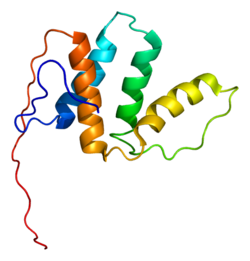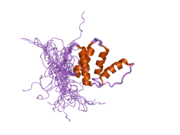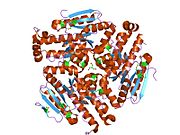- PECI (gene)
-
Enoyl-CoA delta isomerase 2 
PDB rendering based on 2cqu.Available structures PDB 2CQU, 2F6Q Identifiers Symbols ECI2; ACBD2; DRS1; HCA88; KIAA0536; PECI; dJ1013A10.3 External IDs OMIM: 608024 MGI: 1346064 HomoloGene: 38145 GeneCards: ECI2 Gene EC number 5.3.3.8 Gene Ontology Molecular function • fatty-acyl-CoA binding
• dodecenoyl-CoA delta-isomerase activity
• binding
• isomerase activityCellular component • mitochondrion
• peroxisome
• peroxisomal matrix
• intracellular membrane-bounded organelleBiological process • fatty acid metabolic process Sources: Amigo / QuickGO RNA expression pattern 
More reference expression data Orthologs Species Human Mouse Entrez 10455 23986 Ensembl ENSG00000198721 ENSMUSG00000021417 UniProt O75521 Q3TCD4 RefSeq (mRNA) NM_001166010.1 NM_011868 RefSeq (protein) NP_001159482.1 NP_035998 Location (UCSC) Chr 6:
4.12 – 4.14 MbChr 13:
35.07 – 35.12 MbPubMed search [1] [2] Peroxisomal 3,2-trans-enoyl-CoA isomerase is an enzyme that in humans is encoded by the PECI gene.[1][2]
PECI is an auxiliary enzyme that catalyzes an isomerization step required for the beta-oxidation of unsaturated fatty acids.[supplied by OMIM][2]
References
- ^ Geisbrecht BV, Zhang D, Schulz H, Gould SJ (Aug 1999). "Characterization of PECI, a novel monofunctional Delta(3), Delta(2)-enoyl-CoA isomerase of mammalian peroxisomes". J Biol Chem 274 (31): 21797–803. doi:10.1074/jbc.274.31.21797. PMID 10419495.
- ^ a b "Entrez Gene: PECI peroxisomal D3,D2-enoyl-CoA isomerase". http://www.ncbi.nlm.nih.gov/sites/entrez?Db=gene&Cmd=ShowDetailView&TermToSearch=10455.
Further reading
- Maruyama K, Sugano S (1994). "Oligo-capping: a simple method to replace the cap structure of eukaryotic mRNAs with oligoribonucleotides". Gene 138 (1–2): 171–4. doi:10.1016/0378-1119(94)90802-8. PMID 8125298.
- Suzuki Y, Yoshitomo-Nakagawa K, Maruyama K, et al. (1997). "Construction and characterization of a full length-enriched and a 5'-end-enriched cDNA library". Gene 200 (1–2): 149–56. doi:10.1016/S0378-1119(97)00411-3. PMID 9373149.
- Suk K, Kim YH, Hwang DY, et al. (1999). "Molecular cloning and expression of a novel human cDNA related to the diazepam binding inhibitor". Biochim. Biophys. Acta 1454 (1): 126–31. PMID 10354522.
- Scanlan MJ, Gordan JD, Williamson B, et al. (1999). "Antigens recognized by autologous antibody in patients with renal-cell carcinoma". Int. J. Cancer 83 (4): 456–64. doi:10.1002/(SICI)1097-0215(19991112)83:4<456::AID-IJC4>3.0.CO;2-5. PMID 10508479.
- Wiemann S, Weil B, Wellenreuther R, et al. (2001). "Toward a catalog of human genes and proteins: sequencing and analysis of 500 novel complete protein coding human cDNAs". Genome Res. 11 (3): 422–35. doi:10.1101/gr.GR1547R. PMC 311072. PMID 11230166. http://www.pubmedcentral.nih.gov/articlerender.fcgi?tool=pmcentrez&artid=311072.
- Simpson JC, Wellenreuther R, Poustka A, et al. (2001). "Systematic subcellular localization of novel proteins identified by large-scale cDNA sequencing". EMBO Rep. 1 (3): 287–92. doi:10.1093/embo-reports/kvd058. PMC 1083732. PMID 11256614. http://www.pubmedcentral.nih.gov/articlerender.fcgi?tool=pmcentrez&artid=1083732.
- Suzuki Y, Tsunoda T, Sese J, et al. (2001). "Identification and characterization of the potential promoter regions of 1031 kinds of human genes". Genome Res. 11 (5): 677–84. doi:10.1101/gr.164001. PMC 311086. PMID 11337467. http://www.pubmedcentral.nih.gov/articlerender.fcgi?tool=pmcentrez&artid=311086.
- Janssen U, Stoffel W (2002). "Disruption of mitochondrial beta -oxidation of unsaturated fatty acids in the 3,2-trans-enoyl-CoA isomerase-deficient mouse". J. Biol. Chem. 277 (22): 19579–84. doi:10.1074/jbc.M110993200. PMID 11916962.
- Wang Y, Han KJ, Pang XW, et al. (2002). "Large scale identification of human hepatocellular carcinoma-associated antigens by autoantibodies". J. Immunol. 169 (2): 1102–9. PMID 12097419.
- Strausberg RL, Feingold EA, Grouse LH, et al. (2003). "Generation and initial analysis of more than 15,000 full-length human and mouse cDNA sequences". Proc. Natl. Acad. Sci. U.S.A. 99 (26): 16899–903. doi:10.1073/pnas.242603899. PMC 139241. PMID 12477932. http://www.pubmedcentral.nih.gov/articlerender.fcgi?tool=pmcentrez&artid=139241.
- Mungall AJ, Palmer SA, Sims SK, et al. (2003). "The DNA sequence and analysis of human chromosome 6". Nature 425 (6960): 805–11. doi:10.1038/nature02055. PMID 14574404.
- Ota T, Suzuki Y, Nishikawa T, et al. (2004). "Complete sequencing and characterization of 21,243 full-length human cDNAs". Nat. Genet. 36 (1): 40–5. doi:10.1038/ng1285. PMID 14702039.
- Feng X, Chuhjo T, Sugimori C, et al. (2004). "Diazepam-binding inhibitor-related protein 1: a candidate autoantigen in acquired aplastic anemia patients harboring a minor population of paroxysmal nocturnal hemoglobinuria-type cells". Blood 104 (8): 2425–31. doi:10.1182/blood-2004-05-1839. PMID 15217832.
- Gerhard DS, Wagner L, Feingold EA, et al. (2004). "The status, quality, and expansion of the NIH full-length cDNA project: the Mammalian Gene Collection (MGC)". Genome Res. 14 (10B): 2121–7. doi:10.1101/gr.2596504. PMC 528928. PMID 15489334. http://www.pubmedcentral.nih.gov/articlerender.fcgi?tool=pmcentrez&artid=528928.
PDB gallery Categories:- Human proteins
- Chromosome 6 gene stubs
Wikimedia Foundation. 2010.


